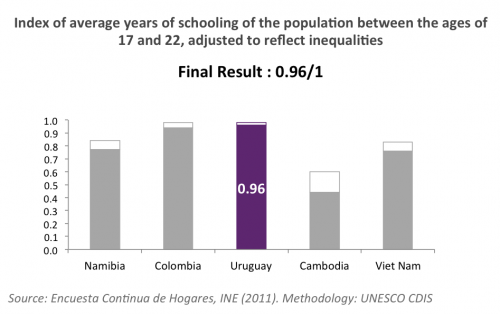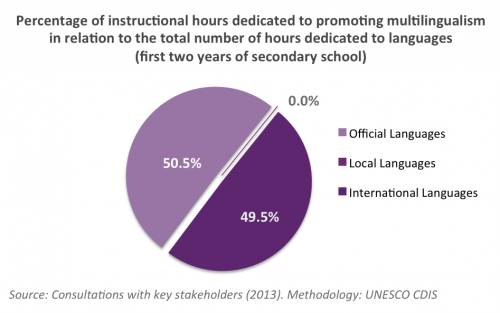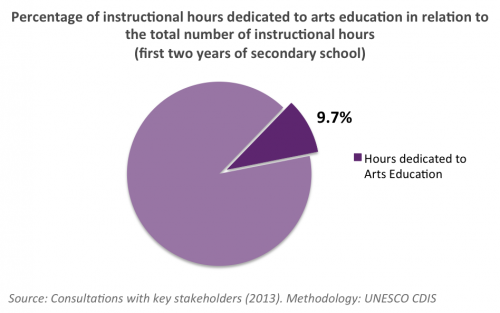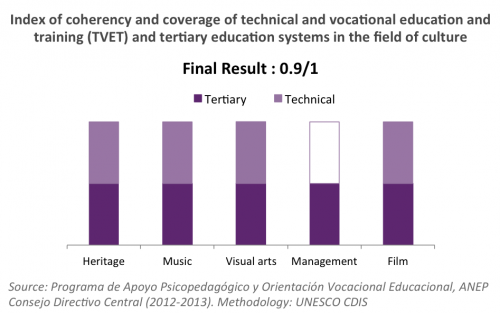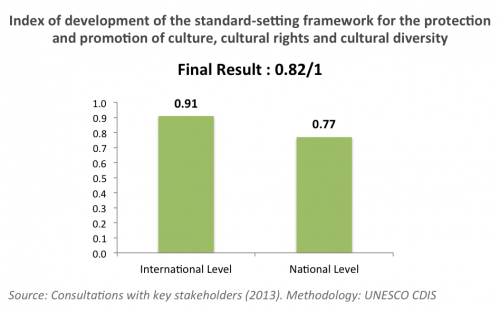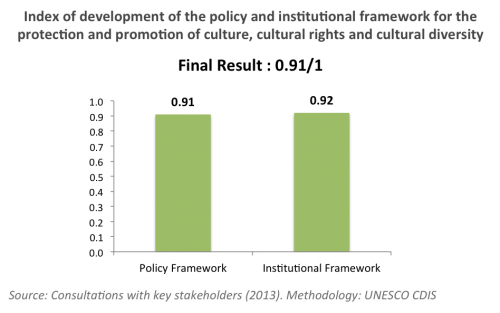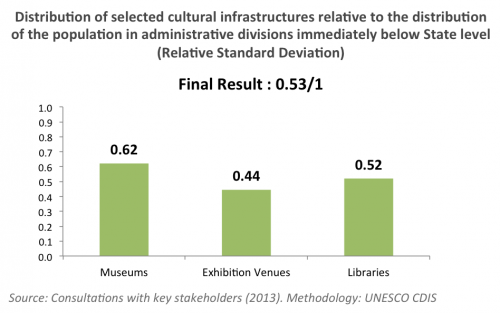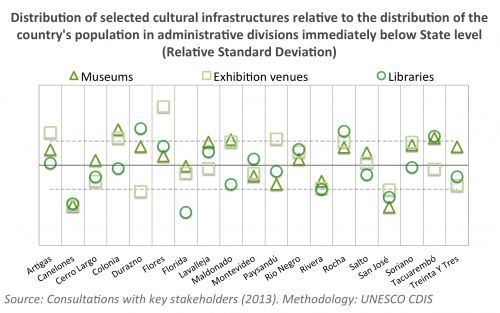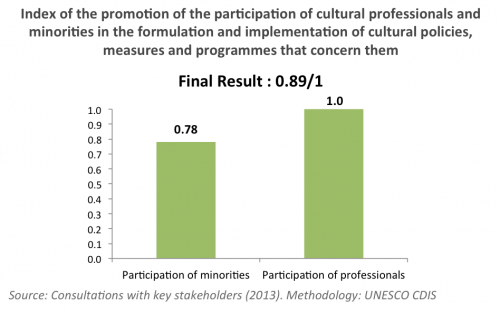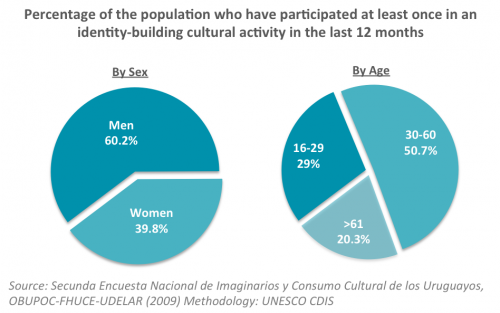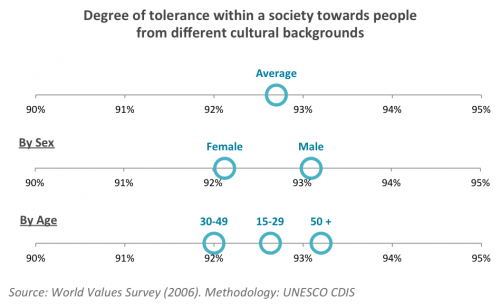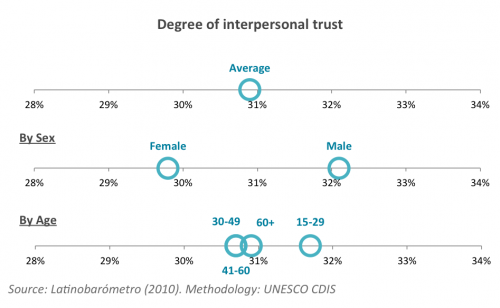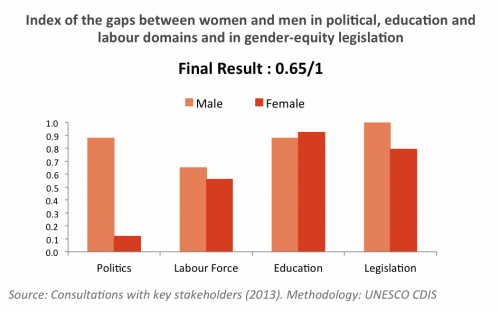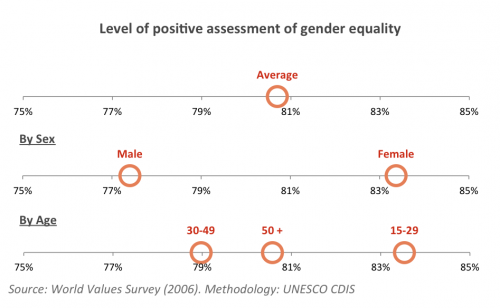
CDIS | Uruguay's indicators
Culture matters in Uruguay: CDIS indicators highlight Uruguay’s culture sector’s potential for economic development and wellbeing, while underlining certain obstacles in place that inhibit it from reaching its full potential.
The results suggest that culture is already an important contributor to Uruguay’s economy and that there is a high level of domestic cultural production, illustrated by the significant percentage of the population with cultural occupations 2 (3.1% of the total employed population) and the domestic consumption of cultural goods and services 3 (3.08 % of total household consumption expenditures). However, while positive results for indicators on the normative, policy and institutional frameworks for culture and heritage 8 9 22(0.82/1; 0.91/1; 0.75/1) suggest that public support of the sector is having a beneficial impact on the production, distribution and enjoyment of select domestic cultural goods like films, indicators pointing to a high level of demand for the participation in cultural activities (68.8%; 67.3%) but the ongoing unequal distribution of cultural infrastructures 10 (0.53/1) suggest that increasing equitable access to facilities in all 19 Departments of Uruguay may further enhance participation, the consumption and enjoyment of cultural goods and services across all socio-economic groups and thus, the domestic market potential of the sector.
The impact of cultural governance is also reflected by Uruguayans benefitting from the cultural right to an education 4 (0.96/1) and opportunities to explore arts and culture subjects in key formative years at school 6 (9.67%). However, additional support to foster the cultural industries could be generated by filling the remaining gap in the offering of professional training programmes in culture 7 (0.9/1) and extending cultural management courses to the TVET level, which could assist in effectively managing cultural enterprises. Furthermore, stimulating a competitive creative class may be the necessary push to fuel dynamic cultural and creative industries, capitalizing on the basic prerequisites already in place for an enabling political, economic, legal, social and cultural context that facilitates benefitting from culture as a medium of expression and satisfaction, illustrated by the guarantee of the freedoms of expression 19 (75/100) and self-determination (7.48/10).
Finally, through increased access to cultural activities and facilities, the potential of culture to reinforce feelings of mutual understanding, solidarity and trust may also be enhanced, helping to resolve the gap between indicators on intercultural tolerance and interpersonal trust (92.7%; 30.9%). Similarly, while international cultural diversity is already promoted through language programmes in schools, strengthening the promotion of multilingualism 5 (49.5%) by increasing exposure to all existing languages in the country may likewise promote cross-cultural understanding amongst the people of Uruguay and foster social cohesion. For culture to further contribute to wellbeing, focus may need to be placed on transforming positive cultural values and attitudes into objective outputs of gender equality 17 18 (0.65/1; 80.7%) in key areas such as labour force and political participation.
1020
2 CULTURAL EMPLOYMENT: 3.1% (2012)
In 2012, 3.1% of the employed population in Uruguay had cultural occupations, 43% of which were women and 57% men. 83% of these individuals held central cultural occupations, while 17% held occupations in supporting or equipment related activities. The sub-sectors that contributed the most to national cultural employment include handicraft workers (22.5%); architects, planners, surveyors and designers (17.7%); teachers of arts and culture (16.2%); and creative and performing artists (11.7%).
Though this result already emphasizes culture’s importance as a provider of employment and wellbeing in the country, the global contribution of the culture sector to employment is underestimated in this indicator due to the difficulty of obtaining and correlating all the relevant data. This figure likely does not cover all informal employment in the culture sector due to the reluctance of some participants to convey such occupations during official surveys. In addition, this figure does not cover induced occupations with a strong link to culture or non-cultural occupations performed in cultural establishments. Nevertheless, in regards to the latter constraint, an additional indicator illustrates that 2.8% of the total employed population worked in cultural establishments in 2012, highlighting a similarity to the core indicator and reinforcing its validity.
To further enhance culture’s economic role, Uruguay has adopted a cluster policy for culture sub-sectors, which promotes links between companies, research institutions, private sector institutions and government bodies in order to promote the activity of each sub-sector with an emphasis on economic contributions and the development of each sub-sector as a creator of income, exports, employment and wellbeing.
1021
3 HOUSEHOLD EXPENDITURES ON CULTURE: 3.08% (2005-2006)
In Uruguay, 3.08% of household consumption expenditures were devoted to cultural activities, goods and services in the year of 2005-2006. 72.8% was spent on central cultural goods and services, and 27.2% on equipment/supporting goods and services. The consumption of cultural services was responsible for the largest share of central goods and services consumed (48%). Cultural services include entry fees to cinemas, museums, theatres, concerts, national parks and heritage sites, the hire of equipment for culture (televisions, video cassettes) etc. The purchase of books was responsible for the second largest share of central goods and services consumed (13%), and the repair of equipment for the reception, recording and reproduction of sound and pictures (such as televisions, radios, stereos etc.) was responsible for the largest shares of equipment/supporting goods and services (13%).
This result suggests a significant demand for cultural goods, though variations in the consumption of cultural goods and services can be noted across income quintiles suggesting that an increase in consumption of cultural goods corresponds to an increase in wealth. This data should be taken into account when analyzing policies and mechanisms in place to permit individuals of all income groups to participate in cultural activities and the consumption of cultural goods and services.
Though already significant, this final result of 3.08% is a sub-estimation of the total actual consumption of households. It does not account for the value of cultural goods and services acquired by households and provided by non-profit institutions at prices that are not economically significant (e.g. in-kind transfers). For example, it does not include museum and public library services and free public cultural events.
>> While the Economy indicators suggest that there is a non-negligible demand for the consumption of cultural goods, services and activities, and that culture is already a significant employer, cross-analysis with CDIS indicators from the Communication and Governance dimensions suggests that the potential for production and the domestic consumption of cultural goods could be further enhanced by reinforcing support of local cultural industries and the equal distribution of cultural infrastructures.
1022
4 INCLUSIVE EDUCATION: 0.96/1 (2011)
‘Secular, free and compulsory’ education has been installed in Uruguay since the Valerian Reform in 1876. Primary education is accessible to nearly all citizens since the second half of the twentieth century, and the illiteracy rate is low amongst Uruguayans. Within this context, the result of 0.96/1 reflects the success of national authorities in guaranteeing the fundamental cultural right to education in a complete, fair and inclusive manner. This result shows that on average, the target population aged 17-22 has 9.8 years of schooling, which is only slightly below the targeted average of 10 years. In addition, only a very small minority of 2% of the target population lives in education deprivation, having less than 4 years of schooling. This result shows that public authorities’ efforts have been overwhelmingly successful in assuring that citizens enjoy the cultural right to an education, and participate in the construction and transmission of values, attitudes and cultural skills throughout school, as well as benefit from the personal and social empowerment of learning. Nevertheless, to further enhance education opportunities in the country, targeted policies may still be necessary to address high repetition rates in primary school, educational underachievement and high dropout rates in high school, which continue to be highlighted as key obstacles by the Ministry of Social Development and the Ministry of Education and Culture (2011).
1023
5 MULTILINGUAL EDUCATION: 49.5% (2011)
The Education Act of 2008 states that “language education will aim to develop the communication skills of individuals, mastery of written language, respect for linguistic diversity, reflection on language, the consideration of the different mother tongues in the country (Uruguayan Spanish, Uruguayan Portuguese, Uruguayan Sign Language), and multilingual education through the teaching of second languages and foreign languages” (Article 42).
In 2011, 49.5% of the hours to be dedicated to languages in the first two years of secondary school was to be dedicated to the teaching of the official national language- Spanish. The remaining 50.5% of the time was to be dedicated to the teaching of international languages, dominated by the teaching of English. These results indicate the priority given by the Uruguayan educational system to the promotion of international linguistic diversity and bilingualism. It should be noted that non-verbal languages are not considered for the construction of this indicator according to CDIS methodology.
However, in spite of the promotion of diversity, Portuguese, a spoken language, is not part of the required curriculum in schools as a local, regional or foreign language despite its recognized status and importance within the South American continent. Nevertheless, select learners in the regions bordering Brazil may now have the opportunity to partake in Education Immersion Programs in Portuguese during primary education. The objective of these programs is to promote academic achievement of oral and writen standard Spanish and Portuguese, respecting the border region’s diversity and exchanging amongst communities. Such initiatives could be reinforced throughout the country at various levels of the education system to provide Uruguayans enhanced language opportunities and promote cultural exchanges with their geographic neighbors.
1024
6 ARTS EDUCATION: 9.7% (2011)
In 2011, 9.7% of the total instructional hours in the first two years of secondary education was to be devoted to arts education. This result is above the average for countries having implemented the CDIS, which is around (4.84%), and is reflective of authorities’ recent commitment to increase opportunities in arts and culture.
Recent changes have been implemented in public educational programs in Uruguay. Arts education was diversified with the creation of artistic programmes for upper secondary schools in 2007. From 2009 onwards, a new Primary Education Program has been implemented and includes courses for artistic knowledge, breaking from previous programs where arts and culture were absent. These changes, both in secondary and in primary schools, reflect improvement in the degree of valorization of arts education in Uruguayan public education. Through arts and cultural education, horizons for personal development and cultural participation are expanded. Although no major recent changes have occurred for basic secondary education, these amendments confirm authorities’ intention to encourage the development of artistic talent; ensure the training of producers of cultural content, goods and services; and foster the appreciation and consumption of cultural and artistic expressions.
1025
7 PROFESSIONAL TRAINING IN THE CULTURE SECTOR: 0.90/1 (2013)
Uruguay’s result of 0.90/1 indicates that the national authorities have manifested a clear interest and willingness to invest in the training of cultural professionals. The coverage of the national public and government-dependent private technical and tertiary education is rather comprehensive, offering various programmes in higher education to citizens who want to undertake technical and professional studies in the field of culture.
Although Uruguayans benefit from both primary and secondary opportunities in arts education, one key gap remains in the training of cultural professionals. The field of cultural management is not represented in Uruguay’s technical and vocational educational system. Transforming artistic and creative capacities into economically viable activities, goods and services and the effective management of cultural businesses requires considering culture-specific aspects of the sector. A lack of training in cultural management may hinder the emergence of a dynamic cultural class and the development of competitive cultural enterprises. Nevertheless, to meet such training needs at the tertiary level, a new Diploma Programme in Cultural Management was created in 2013 as a graduate specialization offered by the Universidad de la Republica.
Also to be noted are other opportunities created in 2013, such as a 2-year technical training programme in film and video at the Universidad del Trabajo del Uruguay (UTU), which have helped to complete the coverage of education in the country. As part of the latter programme, the first-ever specialized technical audio-visual course has been made available on the capture and processing of sound and image. Such recent developments are signs that efforts are being made to address education and training gaps to be filled.
1028
8 STANDARD-SETTING FRAMEWORK FOR CULTURE: 0.82/1 (2013)
Uruguay’s result of 0.82/1 indicates that there is already a reasonable standard-setting framework for culture in place and that the country has made many efforts to ratify key international legal instruments affecting cultural development, cultural rights and cultural diversity, as well as to establish a national framework to recognize and implement these obligations.
Uruguay scored 0.91/1 at the international level, highlighting the degree of priority given to culture and the country’s high level of commitment to international norms on cultural development, cultural rights and cultural diversity. Uruguay has ratified all recommended conventions, declarations and recommendations, with the exception of the Convention on the Protection of Underwater Cultural Heritage, the UNIDROIT Convention on Stolen or Illegally Exported Cultural Objects, and the Brussels Convention Relating to the Distribution of Programme-Carrying Signals Transmitted by Satellite.
At the national level, a lower score of 0.77/1 indicates that public efforts have been made to integrate many of the international obligations that Uruguay has adopted into national legislation, a vital step for the active implementation of these obligations. However, room for improvement still remains as several key items continue to be missing from the national legislation and regulatory frameworks. For example, certain key provisions and cultural rights have yet to be explicitly integrated in the national constitution, such as the right to participate in cultural life, and the recognition and respect of linguistic and cultural diversity. Furthermore, no ‘framework law’ for culture yet exists. Nevertheless, within the Ministry of Education and Culture, the National Directorate of Culture has begun drafting such a bill for future consideration. Such improvements in the national framework and its continual updating are a priority of authorities. For example, in 2005, Law 17.930 on the National Budget for the Promotion of Arts and Culture was adopted; offering companies the possibility of tax breaks if they support cultural projects, helping to promote the sector and create a favourable environment. Another example of on-going improvement, the Commission for the Cultural Heritage of the Nation has been working on a new draft bill, updating heritage law to include concepts such as intangible heritage. In 2008, the Status of the Artist and Related Trades (Law 18,384) was established extending social security benefits of performing artists. Furthermore, consultations had also begun regarding reform and the recognition of the specific circumstances of writers and visual artists in existing regulations on the Status of the Artist. Finally, one more bill currently under deliberation is the Services and Audiovisual Communication Bill, which is meant to update the Radio and Television Law of 1977. This new bill proposes means to promote the production of quality national content, and specifically educational programs and television fiction for children and adolescents. The latter merits consideration when analyzing the indicators of the Communication Dimension. Finally, it is to be noted that the country has shown a clear interest in ensuring continuous opportunities for training to accompany the process of institutionalization of culture through the professionalization of its actors. The Stimulus Fund for Artistic Training and Creation (FEFCA) was created by Article 507 of Law 18,719 .
1029
9 POLICY AND INSTITUTIONAL FRAMEWORK FOR CULTURE: 0.91/1 (2013)
The final result of 0.91/1 reflects the many efforts of national authorities to establish targeted policies and mechanisms to promote the culture sector and implement the obligations and priorities found in national legislation, while revealing the select remaining improvements necessary in the policy framework and administrative system. Uruguay’s results are just above the average result of test phase countries of the CDIS, which is 0.79/1.
Uruguay scored 0.91/1 for the Policy Framework sub-indicator, indicating that many well-defined culture and sectoral policies and strategies have been put in place. One priority seen in national policy is the promotion of access and participation of minorities and other groups with specific needs in cultural life, demonstrated through many policies and programs that target marginalized groups. For example, Ministry of Education and Culture (MEC) Centres for Digital Literacy offer workshops relating to different forms of artistic expression in towns with fewer than 5000 inhabitants. In addition, Grant Funds for Culture have been decentralized to the Department level to help promote local development of the sector, and since 2009, the Fund for the Development of Cultural Infrastructure in the Interior of the Country has aimed to increase access and the quality of cultural centres available to those that are the most isolated and socially marginalized. Many such actions are led by the Cultural Citizenship Unit of the National Directorate of Culture (MEC) and merit consideration when cross-analyzing with the other indicators of this dimension. The main gap in the national cultural policy framework is the lack of integration of culture in national development strategies and plans, a key obstacle to the systematic inclusion of culture in development activities.
Uruguay scored 0.92/1 for the Institutional Framework sub-indicator, which assesses the operationalization of institutional mechanisms and the degree of cultural decentralization. Many positive factors account for such a result. Multiple institutions have been founded for the management and promotion of specific cultural sub-sectors, such as the National Institute of Performing Arts founded in 2010 and the Department of Cinema and National Audiovisuals founded in 2011, which unified National Television, National Broadcasting and the Institute of Cinema and Audiovisuals of Uruguay. Regarding the decentralization of cultural governance, since 2012, Uruguay has a Network of Departmental Directors of culture to promote dialogue and horizontal exchange on culture at the Department level of government. However, no specialized institutions or positions for culture have yet been established at the local/municipal level of public administration. While overall the results for this indicator are very positive and reflect the many formal institutions, policies and mechanisms in place in Uruguay, additional research is necessary to go further and evaluate the effective impact of the national policy and institutional framework for culture and the translation of words into action and results.
1030
10 DISTRIBUTION OF CULTURAL INFRASTRUCTURES: 0.53/1 (2013)
Uruguay’s final result is 0.53/1, 1 representing the situation in which selected infrastructure is equally distributed amongst Departments according to the relative size of the population. The score of 0.53/1 thus reflects that across the 19 Departments of Uruguay, there is an unequal distribution of cultural facilities.
When looking at the figures for the three different categories of infrastructures, Uruguay scores 0.62/1 for Museums, 0.44/1 for Exhibition Venues Dedicated to the Performing Arts and 0.52/1 for Libraries and Media Resource Centers. This suggests that the most equal distribution of access exists for Museums, and that the most unequal distribution for Exhibition Venues. All Departments have access to at least one of each category of facility but the concentration relative to population size greatly varies. For example, while Montevideo benefits from relatively proportionate distribution of cultural infrastructures given its population, the bordering Departments of Canelones and San José are amongst the lowest scoring for all three types of selected infrastructures. Several of these Departments’ most populous cities being within the Montevideo Metropolitan Area, many inhabitants use the capital’s facilities to partake in cultural activities, in part explaining the lack of infrastructure development. Similarly, in most Departments the Libraries and Exhibition Venues available are located in major cities, presenting an obstacle to cultural participation as it requires mobility from more rural areas, and prevents the creation of strong ties between cultural centres and communities. Other Departments that are inadequately furnished with cultural facilities relative to population size include the Rivera Department bordering Brazil, having a total of only 4 Museums (2%), 2 Exhibition Venues (1.6%) and 6 Libraries (1.6%) but 3.2% of the total population.
It is interesting to note that amongst the Departments with the most access to cultural infrastructure are those like Colonia and Maldonado, which are characterized by significant flows of tourists. In Maldonado, Punta del Este is one of the main national tourist attractions and 5 of 12 Exhibition Venues of the entire Department are located in the city despite only 6% of the total population of the Department living in the area. This suggests a relationship between available infrastructures and the cultural consumption habits of a mobile tourist population. While such a correlation contributes to the development of cultural industries and the cultural economy for foreign consumption, increasing the equality of access across all 19 Department could increase opportunities for Uruguayans to take part in cultural activities, promote the development of the cultural and creative industries for domestic consumption and enjoyment, and provide an enabling environment for cultural professionals and businesses to create, produce, promote and disseminate their work. A detailed analysis of cultural participation could assist in assuring appropriate supply of cultural facilities, taking into account the characteristics of cultural consumption of the population and the artistic and cultural offerings available (time availability, ticket prices, dissemination and outreach strategies, etc.). This is a crucial and common challenge among all the countries that have implemented the CDIS, as the average score for this indicator is 0.43/1.
1031
11 CIVIL SOCIETY PARTICIPATION IN CULTURAL GOVERNANCE: 0.89/1 (2013)
The final result of 0.89/1 indicates that many opportunities exist for dialogue and representation of both cultural professionals and minorities in regards to the formulation and implementation of cultural policies, measures and programmes that concern them. Such opportunities for participation in cultural governance exist at the national as well as regional and local levels.
To facilitate the participation of cultural professionals in governance, there are several institutional mechanisms and statutory bodies that provide for participation at the local, regional and national levels. One of the key permanent structures that provides a space for dialogue with cultural professions is the National Assembly of Culture, which through intense participation and exchanges between the State, arts and culture trade unions, NGOs and academics, tries to reach a consensus on the direction and priorities of cultural policy. As for statutory bodies, cultural professionals are included in the deliberation and decision processes of many such bodies regarding the implementation of policies and mechanisms meant to benefit the sector and promote the work and status of creative professionals. For example, cultural professionals assist the Certification Commission for the Status of the Artist and Related Trades in the decision to assign the status of ‘professional artist’ to an individual, and they assist the Board of Assessment and Promotion of Cultural Art Projects (CONAEF) in the selection of projects meant to benefit from the Fiscal Incentives Act.
Though less formalized and ad hoc in nature, limited examples do exist showing the punctual participation of minorities in cultural governance and will hopefully lead to enhanced and more institutionalized integration of minorities in decision-making processes in the future. For example, minorities have been included in a national level consultative process regarding the National Plan Against Racism and Discrimination and they have been included in the roundtables concerning the declaration of Candombe as intangible cultural heritage. Though not uniquely specific to culture, select government structures are already formalizing minority participation in stable decision-making mechanisms, such as the Department of Afro Women of the Ministry of Social Development. Nevertheless, the dissemination and regularity of these mechanisms can still be further developed at all levels of public administration and further analysis of their ability, as well as that of cultural professionals, to effectively influence the formulation and implementation of cultural policies and measures may be necessary.
1033
PARTICIPATION IN GOING-OUT CULTURAL ACTIVITIES: 68.8% (2009)
In Uruguay, 68.8% of the population 12 years or older participated at least once in a going-out cultural activity in 2009. Going-out cultural activities include visits to cultural venues, such as cinemas, theatres, concerts, music festivals, galleries, museums, libraries, historical and archaeological monuments. Such activities require people actively choosing to attend a particular cultural activity, thus providing insight into the degree of cultural vitality and appreciation of culture. They also imply physical places for encounters to occur between audiences and artists, as well as among audiences, and thus insight into the degree of social interaction and connectivity. A result of 68.8% suggests a relatively high degree of participation in going-out activities overall and a steady base for a domestic cultural audience; the average for countries participating in the CDIS is situated at 46.1%.
The results vary indicating that out of the total, 61% of participants in going-out cultural activities were men and 39% women. Similarly, adults 30-60 years of age (52.3%) represented the majority compared to those 16-29 years of age (27.3%) or above 61 years of age (20.3%). There is also a connection between partaking in cultural outings and being members of the middle and elite classes of society, as most participants were from the highest income group (38.3%) and had at least a secondary education (84.7% of participants had a secondary education or higher). Finally, a geographical divide can also be confirmed as 60.1% of all participants were located in Montevideo. To further stimulate participation amongst youth, women and marginalized populations, and to develop targeted policies to increase access to such cultural activities, the above results merit cross-analysis with the indicators of the Education and Governance dimensions, the latter of which reveals that in the case of Montevideo, over 40% of all cultural infrastructures nation-wide are found in the capital region, suggesting that increasing equitable access to facilities may further enhance levels of participation in going-out cultural activities amongst all, boosting social connectivity and the consumption of cultural goods and services across all socio-economic groups.
1034
PARTICIPATION IN IDENTITY-BUILDING CULTURAL ACTIVITIES: 67.3% (2009)
In 2009, 67.3% of the population 12 years or older participated at least once in an identity-building cultural activity. Participation in identity-building cultural activities includes partaking in amateur cultural practices, popular culture, ethnic culture, community practices and youth culture. For the purpose of this indicator, such activities include carnivals, as well as village, regional and national festivals. Identity-building activities are often at the core of social connectivity and the intangible cultural heritage of a society or group. A result of 67.3% already suggests a relatively high degree of participation in identity-building cultural activities as over two-thirds of the population indicated taking part in such events. However, the result for this indicator is likely an underestimation due to the difficulty of obtaining and correlating all the relevant data. This figure does not include participation in identity-building activities such as ceremonies, rituals or community events (e.g., births, marriages, funerals, rites of passage) as no such data is collected at the national level.
Similar to participation in going-out cultural activities, the results vary indicating that out of the total, 60% of participants in identity-building cultural activities were men and 40% women, the majority of participants were adults 30-60 years of age (50.7%), and most participants had at least a secondary education (78.4% of participants had a secondary education or higher). However, unlike going-out cultural activities, less of a divide is recorded between the capital and other regions, and most participants are from middle-income houses (34.6%), not the wealthiest. Overall, Uruguay’s relatively high results for participation in identity-building cultural activities should be considered as a positive factor for social cohesion, and merit consideration when cross-analyzing with the country’s relatively high averages for the other indicators of this dimension regarding tolerance of other cultures and interpersonal trust.
1035
TOLERANCE OF OTHER CULTURES: 92.7% (2006)
In 2006, 92.7% of Uruguayans agreed that they do not find people of a different culture as undesirable neighbours. This indicator provides an assessment of the degree of tolerance and openness to diversity, thus providing insight into the levels of interconnectedness within a given society. It is a composite result of respondents’ replies regarding neighbours falling under 3 categories: people of a different race, immigrants/foreign workers, and people of a different religion.
Since independence in 1830, Uruguay has faced multiple waves of immigration, significant European influences and pro-assimilation policies meant to create a homogeneous nation out of a mixed indigenous and immigrant society through such mechanisms as the adoption of secularism and a singular national language- Spanish. Though as indicated by the Governance Dimension indicators, cultural diversity has yet to be explicitly integrated in the constitution. In the early 2000s Uruguay’s national policies greatly changed as authorities adopted a series of specific laws in favour of multiculturalism, cultural diversity, and the recognition of diversity’s role in the construction of a national identity. Such laws include the Law against Racism, Discrimination, and Xenophobia and the Law on Immigration. In additional, several new holidays, celebrations and cultural groups have been recognized to stimulate this new way of thinking, including the National Day of Candombe, Charrua Indian Nation Day, and Afro-Uruguayan Culture.
The challenge for the country is to reshape the imagination of a homogenous society, incorporating indigenous people, afro Uruguayans, as well as past and future immigrants' demands for recognition and encouraging cultural communities to maintain aspects of their ethnic heritage, as descendants of immigrants make a visible contribution to building the country. Within this context, a result of 92.7% suggests that a cultural system of values is in place, which nurtures diversity, promotes tolerance, and encourages an interest in new or different traditions, thus creating a social environment favorable to development.
1036
INTERPERSONAL TRUST: 30.9% (2010)
In 2010, 30.9% of the Uruguayan population agreed that most people can be trusted. This indicator assesses the level of trust and sense of solidarity and cooperation in Uruguay, providing insight into its social capital. A result of 30.9% indicates a relatively low level of trust and solidarity, as only one-third of the population responded favourably. Only minimal variations in the results can be seen across genders and sexes. While 32% of men agreed that most people can be trusted, only 30% of women agreed. Variation across age groups ranges from 31.7% of people aged 15-29 to 30.7% for people aged 26-40 and aged 41-60. These results indicate that while recent public efforts have successfully laid a foundation for tolerance, additional efforts may still be needed to enhance the potential of cultural participation to reinforce feelings of mutual understanding, solidarity and cooperation, and to foster trust amongst the diverse people of Uruguay. While 30.9% indicates ongoing room for improvement, Uruguay’s results are above the average for all countries having participated in the CDIS, which is situated at 19.22%, as well as above the results all countries within the region. Nurturing interpersonal trust is a common obstacle amongst participating countries. In this regard, the challenge facing Uruguay is to continue to develop and implement policies to promote cultural diversity so that the basis of trust is not a homogeneous identity that weakens cultural differences, but to the contrary the recognition and respect of such cultural differences.
1037
16 FREEDOM OF SELF-DETERMINATION: 7.48/10 (2006)
Uruguay’s final result is 7.48/10, 10 representing the situation in which individuals believe that there is ‘a great deal of freedom of choice and control’ and 1 being ‘no freedom of choice and control.’ The score of 7.48/10 indicates that the majority of Uruguayans feel that they have a relatively high degree of control over their lives and are free to live the life they choose, according to their own values and beliefs. By assessing this freedom, this indicator evaluates the sense of empowerment and enablement of individuals for deciding and orienting their development. While the median response for the population is 7.48, variations can be seen according to the age of respondents. The median response was 7.35 for people aged 15-29, 7.52 for peoples aged 30-49 and 7.53 for those aged 50 and above.
These results suggest a rather high level of individual agency in Uruguay overall, above the average results for all countries having implemented the CDIS, which is situated at 6.7/10. This indicates that for the majority of citizens, Uruguay provides the necessary enabling political, economic, social and cultural context for individual well-being and life satisfaction and builds common values, norms and beliefs which succeed in empowering them to live the life they wish.
1026
17 GENDER EQUALITY OBJECTIVE OUTPUTS: 0.65 /1 (2013)
Gender equality has been positioned as a recent objective of the Uruguayan government, as illustrated by the 2005 establishment of the National Institute for Women, within the Ministry of Social Development. The new institute is responsible for designing the First National Plan for Equal Opportunities and Rights from the Law 18.104 of 2007 on Equal Rights and Opportunities between men and women in the country. The objective is to ensure the guarantee and exercise of full social, political, economic and cultural rights for all; women and men’s equal participation in development processes; and the promotion of necessary cultural change to allow for such equal opportunities. Such an institutional achievement illustrates the ongoing progress since women were first guaranteed their full civil rights in 1946.
Within this context, the result of 0.65/1 reflects a medium degree of gender equality objective outputs and public efforts made to effectively elaborate and implement laws, policies and measures intended to support the ability of women and men to enjoy equal opportunities and rights. Uruguay’s result suggests that the governments’ actions are similar to those of other countries as the average result for test phase countries of the CDIS is situated at 0.64/1. Though indicative of genuine progress, a detailed analysis of the four areas covered by the indicator reveals persisting gaps where additional investment is needed to further improve gender equality outputs.
Little significant divergence can be noted in the areas of gender equity legislation or education (women aged 25 years have a slightly higher average of 9.26 years of education compared to men with 8.8 years). However, more prominent gaps can be seen regarding labour force and political participation. Progress still needs to be made regarding employment. 65% of men are either employed or actively searching for work, versus 56% of women. Women also reportedly continue to face lower wages, occupy lower positions and find it difficult to ascend within the hierarchy of their employers. Finally, the most significant gap is observed regarding the outcomes of political participation where a major imbalance persists. In 2012, women only represented 12% of parliamentarians. Despite the first women having been elected to Parliament in 1942, they continue to face great difficulty in achieving equality. While a slight increase from 15 to 18 female Parliamentarians was recorded in the latest election, this remains significantly low out of the total of 130 seats. Nevertheless, recent efforts are underway to facilitate greater change. In 2000, following the 1992 initiative called Women's Policy Network (Red de Mujeres Politicas), the Women's Caucus (Bancada Femenina) was created to cross partisan lines and build a multiparty legislative agenda on gender. One of the projects presented by the Caucus was the introduction of a quota system for national elections, demanding one-third representation. Several proposals have been presented since and the first quota law will be applied in 2014-2015.
In Conclusion, while Uruguay has made progress in select areas of gender equality, progress remains to be achieved in others. Policies require people, and a further look at the subjective indicator below suggests that Uruguayans are supportive of gender equality, as reflected by their cultural values and perceptions.
1027
18 PERCEPTION OF GENDER EQUALITY: 80.7% (2006)
In 2006, 80.7% of Uruguayans positively perceived gender as a factor for development, according to their responses to questions regarding three key domains that parallel the objective indicator for this dimension- employment, political participation and education. The final result is a composite indicator, which suggests that more than two-thirds of the population of Uruguay view gender as a significant factor for development. Individuals’ perceptions on gender equality are strongly influenced by cultural practices and norms, and Uruguay’s high results reveal a social commitment to gender equality.
However, the perception of gender equality varied according to the domain of the question asked. Unsurprisingly, the most favourable perceptions were recorded in regards to education, correlating with the objective outputs observed. When asked if “University is more important for a boy than for a girl,” an overwhelming majority of 96.2% of the population responded no, suggesting that education is a domain in which gender equality is already strongly perceived as positive for development. When asked if “Men make better political leaders than woman,” a slightly lower majority of 79.5% of respondents did not agree, and when asked if “When jobs are scarce, men should have more right to a job than women,” 69.3% of respondents did not agree. This means that roughly 30% of the population continues to believe that men have priority in regards to employment. While all figures are relatively high and do not correspond to the ongoing gaps in employment and political objective outputs, the most surprising figure regards the highly positive perception of womens’ role in political participation which is in stark contrast with the low representation of women in Parliament.
>> This cross-analysis of the subjective and objective indicators reveals inconsistencies in regards to the population’s positive attitudes and values regarding gender equality and their translation into tangible outcomes, particularly in the areas of labour force and political participation. Thus, these results suggest a need for enhanced measures and public investment to assure the translation of values into performance outcomes and effective opportunities for men and women in such areas as politics and employment. More initiatives like the new quota law to be implemented in 2014-2015 will put Uruguay on the right path to closing the gap.
1016
19 FREEDOM OF EXPRESSION: 74/100 (2012)
The Constitution of the Republic of Uruguay, adopted in 1989, guarantees that within the limits set forth by the Constitution and by law, the expression and communication of thoughts and opinions and the dissemination of information by word, writing or image, is entirely free via any form of media.
Uruguay’s score of 74/100 indicates that their print, broadcast, and internet-based media is currently ‘free’, falling just above the benchmark of ‘free’ media. This score illustrates the efforts made to support an enabling environment in Uruguay for free media to operate and in which freedom of expression is respected and promoted. Such an environment is a condition for fostering the free flow of ideas, knowledge, information and content, for building knowledge societies, and enhancing creativity, innovation and cultural diversity.
However, an additional subjective indicator reveals that in 2009, only 55.5% of Uruguayans agreed that freedom of speech was fully guaranteed and applied, contradicting the assessment that press is free. The remaining 44.5% of the population did not feel that this freedom is fully exercised, though 31.4% did feel that it was ‘fairly guaranteed.’ This additional subjective indicator provides complimentary information on the assessment of the freedom of expression by evaluating to what degree individuals feel that they have the right to exercise this freedom at all times. The significant percentage of the population that continues to feel that this freedom is not fully secure merits further research and analysis to explain this contradiction and suggests that improvements can still be made. For example, in Uruguay the ownership of media continues to be highly concentrated amongst few actors, and a regulatory change is currently being debated which would enlarge access to ownership of media outlets to various sectors, facilitating the effective exercise of the freedom of expression. Moreover, additional achievements undertaken by public authorities in the same year, 2009, suggest that improvements are indeed underway. These achievements include modifications of the Penal Code and Press Law 18515 to improve conformity with international Human Rights treaties, and the creation of the Law 18381 on the Right to Access Public Information.
1017
20 ACCESS AND INTERNET USE: 51.4% (2011)
In 2011, 51.4% of the population aged 5 and above in Uruguay had access to and used the Internet.When compared to the national average in 2006, 29.4%, this result indicates rapid development of the sector and a substantial increase in access of over 20% of the population in just 5 years time.
The development of information technologies, and in particular the Internet, is significantly transforming the way people access, create, produce and disseminate cultural content and ideas, influencing people’s opportunities to access and participate in cultural life. The recent increase in access and use of the Internet can be attributed to government efforts and initiatives that demonstrate the priority given to new technologies. In 2007, the Agency for e-Government and the Information Society (AGESIC) was founded, and a new Digital Agenda Uruguay (2008-2010) was adopted. Through the AGESIC, initiatives like the Plan Ceibal have been carried out, which recognize the potential of new technologies as a means to access diverse content from around the world. Based on the American project ‘One laptop per child,’ in 2011, the Plan Ceibal sought to expand infrastructure and access by delivering 455,970 computers to public schools. The plan has high levels of popular acceptance, in part due to public opinion that the increased access to technology allows children to be be in touch with the world. Public support is so high that voluntary civil society initiatives like the CEIBAL Support Network (RapCEIBAL) have also been established to further support the achievement of objectives.
1018
DIVERSITY OF FICTION FILMS ON PUBLIC TELEVISION (ALTERNATIVE INDICATOR): 18% (2012)
In Uruguay, approximately 18% of the total broadcasting time of fiction films on the public free-to-air television channel is dedicated to domestic fiction films. Uruguay National Television (TNU) is the only public free-to-air channel available nation-wide and has been operating since 1963. Of the 122 fiction films broadcasted throughout the year of 2012, 4 (3.3%) were solely national productions, 18 were co-productions (14.8%) and 100 (81.7%) were of foreign origin. These results indirectly reflect the levels of public support of the audiovisual sector and the dissemination of domestic content produced by local creators and cultural industries.
Cross-analysis with the Governance and Social Participation dimension indicators suggest that public support of the domestic film industry is on the rise and having a positive impact. The first Cinema and Audiovisual Law was enacted in 2008, better structuring and providing assistance for the sector, as well as establishing the Cinema and Audiovisual Institute of Uruguay (ICAU). Prior to this reinforced public support, the ability of the Uruguayan film industry to survive was greatly questioned in the 1990s, given the limited size of the domestic market. In addition to enhanced government efforts, additional factors at the turn of the century favored the blossoming of national film production and consumption: technological advances and digitilization, professionalization of the sector, and increased recognition of the quality of national films thanks to their circulation and awards granted at verious international film festivals. Cross-analysis with the raw data used to construct the CDIS indicator on the participation in going-out cultural activities, indicates that already in 2009, 55% of the population of Montevideo had watched national films on television, while 27.7% had visited theaters to enjoy national cinema productions. In other areas of the country slightly lower results of 44% and 13.7% were recorded respectively. Such figures emphasize a real public demand for the consumption of domestic films and reinforce the argument for continued public efforts to support the production and distribution of domestic audiovisual products. It is to be noted that a new survey on the sector will provide updated data near the end of 2014.
These figures also merit being taken into account when analyzing other indicators concerning cultural production and consumption, such as those of the Economy dimension.
1032
22 HERITAGE SUSTAINABILITY: 0.75/1
Uruguay’s result of 0.75/1 is reflective of the high level of priority given to the protection, safeguarding and promotion of heritage sustainability by public authorities. Many public efforts are dedicated to registrations and inscriptions, community involvement, stimulating support amongst civil society and the private sector. However, persisting gaps in raising-awareness, capacity-building, and conservation and management, call for select additional actions to further enhance this multi-dimensional framework.
The national governing body for the protection, dissemination and preservation of heritage is the Commission of Cultural Heritage of the Nation (CPCN), within the Ministry of Education and Culture (MEC). The CPCN was established by Law 14.040 in October, 1971. In addition to the work of the CPCN, the General National Archives and the National Library maintain collections, and the Ministry of Housing, Urban Planning and Environment is involved in heritage protection through the Protected Areas System.
Uruguay scored 0.77/1 for registrations and insciptions, indicating that efforts to date have resulted in many national and international registrations and inscriptions of Uruguayan sites and elements of tangible and intangible heritage. However, while Uruguay has an outstanding 1,396 heritage sites registered at the national level, 6 elements of intangible heritage inventoried and 1410 items registered as cultural property at the national level, no database of stolen cultural objects yet exists. The latter gap is of particular significance when cross-analyzing with the indicators of the Governance dimension, which illustrate that Uruguay has not yet ratified the UNIDROIT Convention on Stolen or Illegally Exported Cultural Objects (1995).
For public commitment, reflected by registrations and inscriptions, to effectively turn into heritage management, commitment must be translated into specific concrete policies and measures. Uruguay scored 0.73/1 for the protection, safeguarding and management of heritage, indicating that there are many efforts to involve communities, but that select gaps persist regarding capacity-building and conservation, valorization and management. For example, participation of local communities has been increasingly included in decision-making processes to identify and record items of tangible and intangible heritage, communities are represented in the management committees of heritage sites, and specific measures are taken to respect customary practices governing access to certain aspects of intangible heritage. As indicated by the Governance dimension, many clear actions, measures, policies and laws are in place regarding heritage at the national level. However, the role of heritage is not yet explicitly integrated in development plans. Since 2009, authorities have been working on the development of a new Heritage Law that will assist in emphasizing the importance of heritage for development and advocate for better inclusion in development plans. Other key gaps to be noted concern the lack of specialized police or customs units to assist in the fight against illicit trafficking, and the lack of capacity-building and training in this same field. Finally, while the Governance dimension has indicated that many actions, measures, policies and laws exist at the national level regarding heritage, the role of heritage is not yet explicitly integrated into development plans. Since 2009, authorities have been working on developing a new Heritage Law to assist in highlighting the importance of heritage for development and to advocate for its better inclusion in development plans.
Finally, Uruguay scored 0.78/1 for transmission and mobilization of support, reflecting efforts to raise awareness of heritage’s value and meaning amongst citizens, as well as efforts to promote investment in heritage and involve the civil society and private sector. For the protection of heritage to deepen, not only is the urgent attention of authorities necessary, but gaining the attention of Uruguayans is key in order to give heritage the degree of importance that it should occupy in the country. The multidimensional framework could be further enhanced by making heritage more accessible to all via differential pricing for national visitors at protected heritage sites, and by increasing opportunities to build heritage expertise amongst teachers as there are currently no programs to build teacher’s capacities on heritage issues. Finally, it would be useful to implement an awareness campaign targeting youth populations in primary schools.




